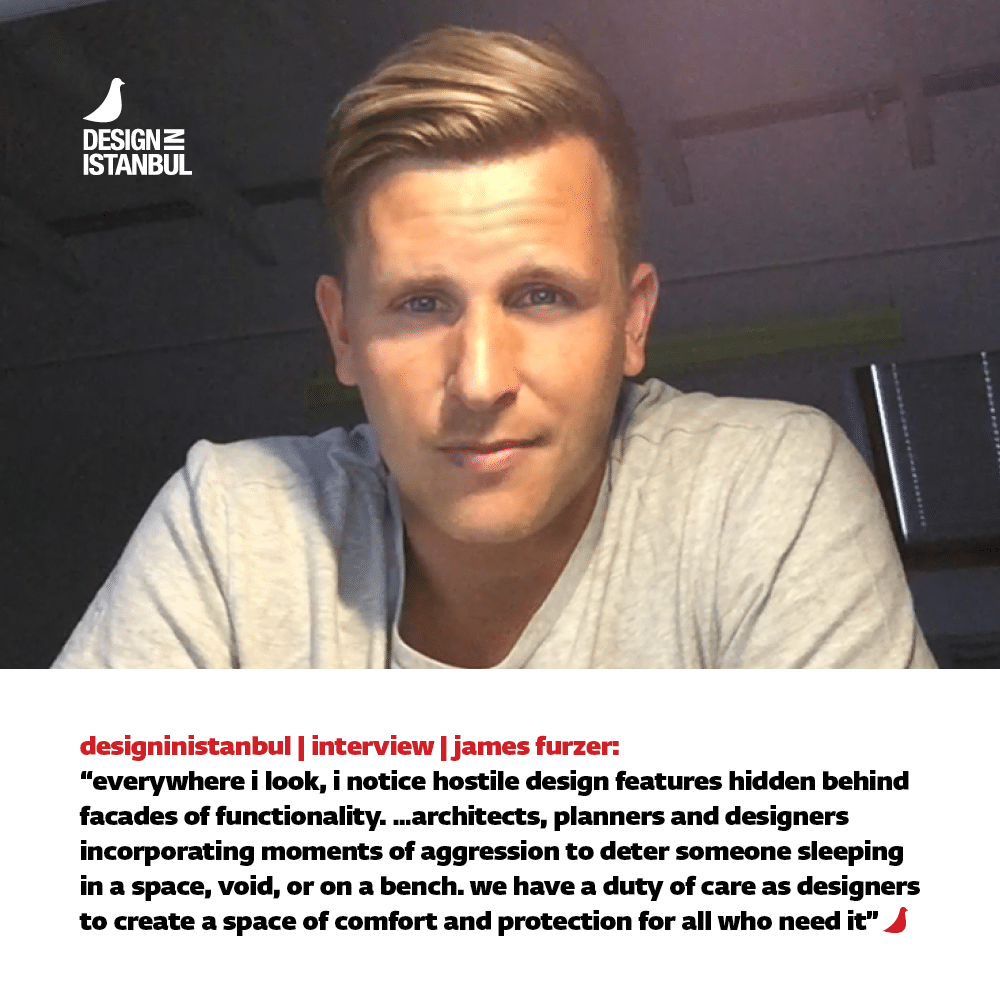
27 Apr interview | james furzer: “everywhere i look, i notice hostile design features hidden behind facades of functionality. …architects, planners and designers incorporating moments of aggression to deter someone sleeping in a space, void, or on a bench. we have a duty of care as designers to create a space of comfort and protection for all who need it”
James Furzer is a young architectural designer best known for his works on the growing problem of homelessness, and especially for his award winning modular houses for the homeless people. With his own words, he is at an early stage of his career, yet with a large amount of industry experience. He is concerned with the recent rise of the “defensive architecture” or “hostile design” features that are contrary to the real duty of the architecture profession: designing spaces of involvement, comfort and security for all. He highlights the importance of collectives, with a stress on the collaboration of design, architecture, policy and public administration, for further steps in designing our cities in a more inclusive direction. We thank James for this delightful interview and deeply thought and studied insights.
Thank you James for being part of the designinistanbul interviews. You are a young architect who has worked in various high-end residential and commercial projects. You are also best known for your works against homelessness for some time, for example through your award winning modular houses for the homeless people and for your recent project on the documentation of benches in London built to discourage homeless people from lying on them. Would you mind sharing your personal and professional story on how you have started to concern yourself as an architect with the homelessness issue?
Thank you very much for taking the time to interview me, and provide me with a further platform to voice my concerns, designs and aspirations. It really is with the help from organisations such as yourselves, providing the correct channels such as this, that help spread our thoughts. Together we can make our cities a truly comforting space.
As a young, ‘up and coming’ architect, I feel that change is required within the industry. I do not class myself as a ‘typical’ architect, not only with my appearance, being covered in visible tattoos etc, but also with the way I believe architecture should be accessible and experienced by all. I’ve always found it so absurd, that personally designed architecture is only really available to those who can afford it, or the working class. A Beautifully designed space should be available to all. As an architect, my design mind is always at the forefront of my thoughts. I believe the way I experience a space is completely different to how others do, breaking down design and functionality. Everywhere I look, I notice hostile design features hidden behind facades of functionality. This has become more apparent in recent times. Architects, planners and designers incorporating moments of aggression to deter someone sleeping in a space, void, or on a bench. We have a duty of care as designers to create a space of comfort and protection for all who need it.
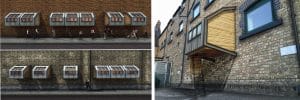
Homes for the Homeless modular houses was awarded 1st place at FAKRO’s International Design Competition in 2015. What happened since then? Could you tell us about the outcomes of this project, and the ways in which it has been received on a broader level?
Since winning the competition, as you are aware, the design gained a very large amount of publicity, more than I could ever have hoped for. Various structural design proposals have been sought and refined to create a design that could be implemented. The project was intended to highlight the issue of homelessness and rough sleeping not only within London, but worldwide. It’s not providing a complete solution to homelessness, it is however creating an instant, temporary solution, that is able to inject a sense of self-worth to those who require it. As all designs, there has been an amount of negative feedback, but that can be expected, not all of us wish to do good in the world. The majority of the feedback was well received and praised.
Concerning the fact that homelessness is a growing problem waiting to be solved everywhere around the globe; what do you think can be done for the locally proven social design projects (in terms of their value and function) to be realized on a broader global level? What are/can be the main channels and mechanisms of this realization?
Spaces could be designed to include the necessities of which those who require designed space immediately at their disposal. If this is the case, it is essential that architects begin to understand the entire use of the spaces they design. The role of the architect then becomes more detailed, with the architect prompting potential uses for the space, and moving away from defining these spaces, but encouraging an array of mixed and multicultural uses. Architecture could be placed in a position in which it encourages the use, thus improving the lives of those who desperately need it more than the clients that the architect generally service for a fee. It appears that current design and policing provisions put in place only shift the homeless community along elsewhere as opposed to benefiting the community. A system that calls for encouragement as opposed to retraction and deterrent.
In your biography, you define yourself as an architectural technician. Is there any particular reason (for example in relation to your professional approach to architecture) that you do not call yourself a designer or architect or an architectural designer?
I simply, am not a fully qualified architect as of yet. I am due to be in a years’ time, but for the time being, I simply cannot brand myself with the RIBA Architect title. My official working title is an architectural technician. I can produce not only designs and concepts, but technical drawings, and project management, due to my large amount of industry experience, which is rare in a young person within the design and construction industry. If I was to put a label on what I do, I’d class myself as an architectural designer. Ultimately, my Goal is to become a fully chartered architect. Having received several international awards already at this early stage in my career, I feel my career is moving in the right decision.
What would you say about the collaboration of craft, art and design as a collective for re-designing the cities by taking into consideration the people with disabilities, homeless people, refugees, and many other vulnerable populations? Could craft, art and design cooperate for our future? Or to ask differently; can craft, art and design find a middle ground based on their particular potentialities in value production for the humankind?
This all depends on what you feel the final outcome is to be. If we are simply looking at making the city a more comfortable environment to those in need and to those who use the cities resources, then I think design takes the forefront and has to be pushed in a direction that has amore utopian vision. If we are talking about potential ‘cures’ for homelessness, refugees etc. (I hate the terminology, cures, solutions etc, as this instantly stereotypes these categories into a negative light), then I think we need to be addressing the issues at a more political view point. Ultimately, just architecture and design alone will not provide the ‘ultimate’ solution, it needs to be a combined effort, incorporating, architecture, design, politics and humanity at an unprecedented level. Co-operation is critical, and I think the cities have to be designed to account for ALL user requirements. Hence a shift in architectural mind.
In your interviews, you state that you do not claim to have a complete solution to the homelessness with this project (homes for the homeless), rather address our need to change our attitudes towards homeless people by acknowledging rather structural and deeper causes underlying this problem. We deeply appreciate your approach in the current design and art scene around the word, part of which bear an inflation of projects objectifying the refugee and homeless crisis. What would you tell about the ways in which the real value productions and concerns can stand out amongst this inflation?
I feel this has been answered above. A shift in mindset is required by all to be more accommodating for those in need. As you state, homelessness is individually deeper than someone sleeping on the streets.
Finally, we would like to ask you a designinistanbul question: where does collectivity stand in relation to the values of craft, art and design?
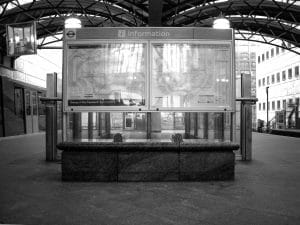
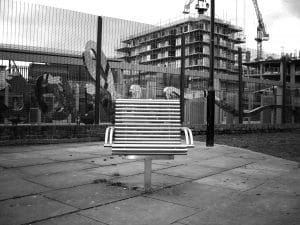 A topic as broad as homelessness, and with the ability to predict the movement and location of individuals, coupled with the requirements and wants of homeless individuals, it can be hard for architects to design to future proof the crisis. This is made harder with client requirements and specifications over conscious public requirements. The undesirables of the community have been, and are continuing to be, designed out of public space. With aspirations to greater understand and apply an architectural discourse regarding the continuing debate on homelessness, the lack of grounded architectural spaces for individuals seeking a sense of home is extremely distressing. It is therefore vital, that the spaces that are provided, welcome a mixed variety of uses and occupier, with different timescales of usage.
A topic as broad as homelessness, and with the ability to predict the movement and location of individuals, coupled with the requirements and wants of homeless individuals, it can be hard for architects to design to future proof the crisis. This is made harder with client requirements and specifications over conscious public requirements. The undesirables of the community have been, and are continuing to be, designed out of public space. With aspirations to greater understand and apply an architectural discourse regarding the continuing debate on homelessness, the lack of grounded architectural spaces for individuals seeking a sense of home is extremely distressing. It is therefore vital, that the spaces that are provided, welcome a mixed variety of uses and occupier, with different timescales of usage.
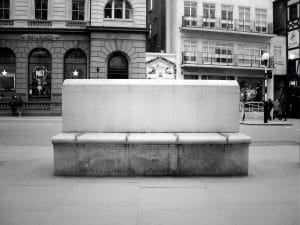
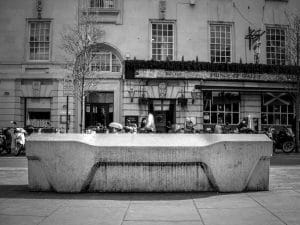 There is a need for architecture and public space to address the physical issue of rough sleeping and homelessness. The profession has a duty of care to design spaces of involvement, comfort and security, and not spaces of exclusion, discomfort and segregation. Examples of bench such as the Camden bench, and the benches directly outside the Royal Courts of Justice in London, show a lack of the designer’s duties being undertaken, hidden behind the noted façade of functionality. A case of who do we want here, and who do we not want here. I can wholeheartedly say, that defensive architecture exists on an unprecedented level, and is sadly on the rise. With design guides instructing designers to incorporate such methods, we need to ask the question of the origin of this style of architecture, along with its actual hidden intentions. We require a friendlier architecture to change the current perception of homelessness.
There is a need for architecture and public space to address the physical issue of rough sleeping and homelessness. The profession has a duty of care to design spaces of involvement, comfort and security, and not spaces of exclusion, discomfort and segregation. Examples of bench such as the Camden bench, and the benches directly outside the Royal Courts of Justice in London, show a lack of the designer’s duties being undertaken, hidden behind the noted façade of functionality. A case of who do we want here, and who do we not want here. I can wholeheartedly say, that defensive architecture exists on an unprecedented level, and is sadly on the rise. With design guides instructing designers to incorporate such methods, we need to ask the question of the origin of this style of architecture, along with its actual hidden intentions. We require a friendlier architecture to change the current perception of homelessness.
“So-called ‘undesirables’ are not the problem. It is the measures taken to combat them that is the problem.”
(Whyte N.D)
James Furzer
